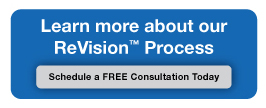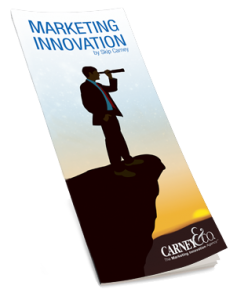Category: Uncategorized
 When we ReVision a client, we start the day with a few simple rules that begin with “Leave your ‘buts’ at the door”. You know the “but” people. They follow every new idea with a “but”. “But we tried that.” “But we can’t afford that.” “But we’ve never done that before!” (more…)
When we ReVision a client, we start the day with a few simple rules that begin with “Leave your ‘buts’ at the door”. You know the “but” people. They follow every new idea with a “but”. “But we tried that.” “But we can’t afford that.” “But we’ve never done that before!” (more…)
I just heard a public service announcement for the Highway Patrol. You’ve heard it before – “This is trooper B. R. Jones reminding you that speed kills. Slow down this holiday weekend. Yadda, yadda.
Sorry Trooper Jones. Speed does NOT kill.

The Autobahn. No limits.
Anyone that has driven on Germany’s autobahn can tell you that speed is not the enemy. When you are driving along at 130-140 kph and an Audi zooms by you like you’re sitting still, you get a whole new appreciation for “speed” and you totally understand it is NOT speed that kills. The statistics prove it: Germany’s fatality rate is nearly half that of the U.S.
So what’s the problem?
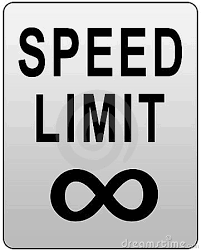 It’s not complicated. When you’re driving with your knees while holding a coffee cup in one hand and a donut in the other while talking on you bluetooth and answering texts, sooner or later, you’re gonna die. In Germany, it is illegal to even use a cell phone while driving, but I promise you, when you are on the autobahn, you are focused on one thing and one thing only…driving. It’s a matter of self preservation. You take your eyes off the road for a millisecond and you are in trouble. In reality, increased speed results in better driving. It’s distractions, lack of concentration, apathy and downright stupidity that kills, and that is the problem officer Jones should be discussing.
It’s not complicated. When you’re driving with your knees while holding a coffee cup in one hand and a donut in the other while talking on you bluetooth and answering texts, sooner or later, you’re gonna die. In Germany, it is illegal to even use a cell phone while driving, but I promise you, when you are on the autobahn, you are focused on one thing and one thing only…driving. It’s a matter of self preservation. You take your eyes off the road for a millisecond and you are in trouble. In reality, increased speed results in better driving. It’s distractions, lack of concentration, apathy and downright stupidity that kills, and that is the problem officer Jones should be discussing.
But that’s not really the point of this blog post.
It’s Conventional Thinking That Kills
 It is this kind of (speed kills) thinking that kills innovation. Conventional wisdom says it’s not “logical” or “practical” to do something, and we immediately drop an otherwise great idea and miss an opportunity to solve a problem or create something new. It’s only when we question the status quo that we create. It’s only when we embrace counter-intuitive thinking that we open doors. Next time you hear something that sounds like conventional thinking, challenge it. You’ll be amazed what you will find.
It is this kind of (speed kills) thinking that kills innovation. Conventional wisdom says it’s not “logical” or “practical” to do something, and we immediately drop an otherwise great idea and miss an opportunity to solve a problem or create something new. It’s only when we question the status quo that we create. It’s only when we embrace counter-intuitive thinking that we open doors. Next time you hear something that sounds like conventional thinking, challenge it. You’ll be amazed what you will find.

We use a powerful, unique ReVision™ process to uncover innovation,
generate bigger ideas, and produce better results for our clients.
Learn more at www.carneyco.com.
It’s clear. A company needs a vision. It has to know where it’s going, why it’s going, and it needs a plan to get there. Without purpose and passion though, a vision is just words on paper…a body without a soul. This is what separates the great companies from the good ones.
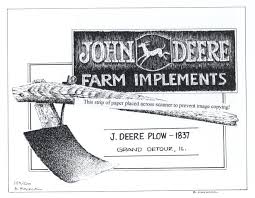 JohnDeere was a blacksmith in the 1830s and he built a new kind of plow to help the local farmers cut through the soil better. He envisioned a company that would supply midwestern farmers with reliable, affordable equipment. That simple vision was backed up by a passion for excellence that has driven his company for over 185 years. Reliability is so completely ingrained in the company and its culture, that no one questions the statement “nothing runs like a deere” because nothing does.
JohnDeere was a blacksmith in the 1830s and he built a new kind of plow to help the local farmers cut through the soil better. He envisioned a company that would supply midwestern farmers with reliable, affordable equipment. That simple vision was backed up by a passion for excellence that has driven his company for over 185 years. Reliability is so completely ingrained in the company and its culture, that no one questions the statement “nothing runs like a deere” because nothing does.
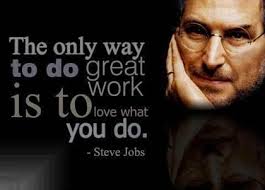 While Steve Jobs has been hailed as the greatest visionary of our times, it was his passion not his vision that made Apple the number one brand in the world. He was determined to build “insanely great products” and his never ending search for the next great product drove him and the company to greatness.
While Steve Jobs has been hailed as the greatest visionary of our times, it was his passion not his vision that made Apple the number one brand in the world. He was determined to build “insanely great products” and his never ending search for the next great product drove him and the company to greatness.
Though separated by 150 years, Deere and Jobs had a lot in common. While their competitors were busy copying their ideas and building tractors and computers, Deere and Jobs were busy looking for better solutions to their customers problems.
That’s what innovators do. They are never satisfied with just building more stuff or making more money. The focus is always on the customer, the customer’s needs and solving the next big problem…passionately.
We use a powerful, unique ReVision™ process to uncover innovation, generate bigger ideas, and produce better results for our clients. Learn more at www.carneyco.com
 I was taking a morning walk around the marina in New Bern the other day. Lots of folks were out for their morning coffee. There were joggers, walkers, talkers… It was a busy, summer morning and I encountered what seemed like an unusual number of attractive ladies. As they approached, each one broke into a huge smile, slowed down and said “good morning”, “so cute”, “awwww”. And not a single one was looking at my eyes. No, they were looking at Poppi, my daughter’s six year old YorkiePoo. Or maybe she’s a Pookie since she is more poodle than yorkie.
I was taking a morning walk around the marina in New Bern the other day. Lots of folks were out for their morning coffee. There were joggers, walkers, talkers… It was a busy, summer morning and I encountered what seemed like an unusual number of attractive ladies. As they approached, each one broke into a huge smile, slowed down and said “good morning”, “so cute”, “awwww”. And not a single one was looking at my eyes. No, they were looking at Poppi, my daughter’s six year old YorkiePoo. Or maybe she’s a Pookie since she is more poodle than yorkie.
To be fair, Poppi is extremely cute and she has never met a stranger. Never. And she still acts like she’s three months old. But seriously, am I invisible? Shouldn’t I get a nod or something?
The answer, of course, is no.
People like what they like and ladies like cute little dogs way more than they like the cute little dog walkers. (That is, walkers of cute dogs.)
 What’s in your marketing?
What’s in your marketing?
Too much of today’s marketing ignores this fundamental fact. People want what they want, even if they don’t know what they want. Too much of today’s marketing simply says “look at me, look at me” instead of just being so doggone irresistible that the buyer can’t help but look. Now, it’s not easy to be irresistible (unless your name is Poppi). It takes hard work to create an offering that cuts through the clutter and strikes a chord with the buyer. It takes effort to craft a message that speaks to the issues that the customer cares most about.
It’s not easy to solve your customer’s problems in a unique, creative way. But, I can tell you this: It’s worth the effort. Better margins, better sales, more loyalty, and less competition.
Take the time, do it right and it’s like walking around with a cute dog on a leash…only better.

We use a powerful, unique ReVision™ process to uncover innovation, generate bigger ideas, and produce better results for our clients. Learn more at www.carneyco.com
I was in Cincinnati recently and saw a sign that intrigued me…. Doughby’s – Calzones, Crepes, and More. My wife loves crepes, so I thought I might pick one up on the way back to the hotel. As I got closer, I saw another sign…for sale. Doughby’s was out of business. No crepes today, so I ambled down the street to join my friends at the Hang Over Easy (HOE, for short). The breakfast was spectacular. The place was packed.
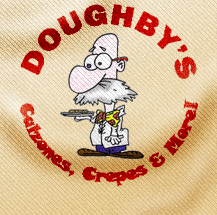 vs.
vs. 
Why does one business fail and another succeed?
It’s easy, actually. When the Doughby team got together, they had an idea. It probably started with a great calzone. College kids love calzones. (They are one block from University of Cincinnati.) And then someone said, “Let’s sell crepes, too. They’re made with dough. ” And before you could say holy mozzarella, they had a menu that included calzones, crepes, wings, salads, cookies, and more.
You’ve got to stand for something.
 Doughby’s mistake was trying to be everything for everyone. You can’t do it. You have to declare a position. You have to be proud of it. You have to own it and live it. Saying “we have everything” is the same as saying “we have nothing”. Plus, the idea that you’re making a calzone right next to my banana/nutella crepe is just plain creepy. Italy and France just don’t belong together. Chicken and waffles? That’s different.
Doughby’s mistake was trying to be everything for everyone. You can’t do it. You have to declare a position. You have to be proud of it. You have to own it and live it. Saying “we have everything” is the same as saying “we have nothing”. Plus, the idea that you’re making a calzone right next to my banana/nutella crepe is just plain creepy. Italy and France just don’t belong together. Chicken and waffles? That’s different.
When less is more.
 Hang Over Easy, on the other hand, offers an easy reason to believe. They keep it simple (breakfast and lunch anytime) and they promise a big, hearty hunk of comfort food to make your hangover “easy”, if that’s your problem. If you just like comfort food, that’s okay, too.
Hang Over Easy, on the other hand, offers an easy reason to believe. They keep it simple (breakfast and lunch anytime) and they promise a big, hearty hunk of comfort food to make your hangover “easy”, if that’s your problem. If you just like comfort food, that’s okay, too.
Hang Over Easy actually offers more by promising less.
And because of that, they are making a lot of dough…a lot more than Doughby’s.
We interrupt this blog for breaking news:
 I can now watch every game in the NCAA Tournament on my iPhone or iPad or Computer. It’ free. It’s easy
I can now watch every game in the NCAA Tournament on my iPhone or iPad or Computer. It’ free. It’s easy
and it’s innovation…in a retro kind of way.
This is BIG. Imagine an entertainment model where the product is delivered absolutely free to the viewer and it is paid for with advertising. Imagine the conversations at the NCAA and CBS when someone suggested such a radical idea. Imagine the BGO (blinding glimpse of the obvious) moment when someone said, “Hey, didn’t we used to do this with broadcast tv?”
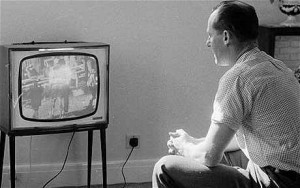 OR we can make it hard.
OR we can make it hard.
Try to watch live TV on your phone right now. You download the apps, log into your cable or satellite account (if you can remember how), answer a magic question, enter a magic code while whistling the national anthem and standing on one foot. This was somebody’s idea of how to “allow” us to use our mobile devices to watch TV. And, by the way, you can only watch the latest episode or two, maybe.
 Enter innovation.
Enter innovation.
Along comes the NCAA saying “We want more people watching the games. Why can’t they watch them in the airport, or in the back seat of the car, or sitting on the couch?” BAM! We got games. All of ‘em. I watched four games last weekend, on my phone, while riding on a train.
Or we can make it easy.
Somebody said, “Let’s make it easy and maybe more people will watch more. More people means more eyeballs, which means happier advertisers.” And that’s innovation. Give people what they want and they will reward you. I predict the highest viewership ever for the NCAA Tourney and I predict that this “broadcast” model can work right along side the “pay per view” model.
If the networks will just wake up and let it happen.
There’s only one problem with the March Madness thing.
Carolina is out and I’m losing interest. I am, however, ready for next year.
The old saying goes “build a better mousetrap and the world will beat a path to your door”…implying that all you have to do is find a better way of doing something and you’ll be a successful innovator.
Not true
Lots of better solutions fail everyday and they fail for two basic reasons: #1 – They aren’t really solutions. #2 – The marketing focuses on the “new and shiny” and neglects the customer’s needs.
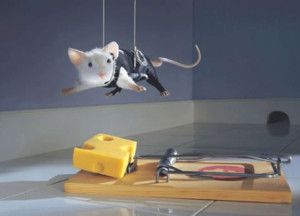 Do you really want to trap mice?
Do you really want to trap mice?
Of course you don’t. The problem is NOT that you need to catch the little critters. The problem is that you don’t want them in your house at all. A truly better solution is the one that keeps the mice out in the first place. A cat, for instance, or a patch in the wall, or mouse repellant, or mouse poison are all better solutions for keeping the mice out.
True innovation gets to the root of the problem and offers a solution that is more than new and improved.  It looks at the problem from a different perspective and offers something that makes the jobs easier, faster, better, cheaper, or whatever matters most to the end user.
It looks at the problem from a different perspective and offers something that makes the jobs easier, faster, better, cheaper, or whatever matters most to the end user.
If you want to innovate in your business, you have to start with your customer’s problems. Understand them, solve them and you will find innovation. Then and only then, are you ready to go to market.
We’ll talk about how you market that innovation next time.
PS. If you really want to trap a mouse, you just can’t beat the old-fashioned, spring-loaded board with a piece of cheese.
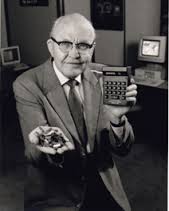 This is a story about the little things. The little things that solve little problems that give customers what they want and bring success to the little thing innovator. Hewlett-Packard had great success with the handheld calculator but they did NOT invent the handheld calculator. That honor belongs to Texas Instruments. The first calculator was big and bulky and cost $2500.
This is a story about the little things. The little things that solve little problems that give customers what they want and bring success to the little thing innovator. Hewlett-Packard had great success with the handheld calculator but they did NOT invent the handheld calculator. That honor belongs to Texas Instruments. The first calculator was big and bulky and cost $2500.
What makes ours special? Nothing. Except…
 That was 1967. By the 70’s, Hewlett-Packard and others had knocked off the idea and the price had dropped to about $75. Bill Hewlett was talking with the ad team of Dick Orkin and Bert Berdis about an ad campaign to sell more calculators. They asked “What makes your product special?” He replied, “Nothing. They all perform the same functions. They all cost about the same. Nothing.” And then he said, “…we do have one little thing. The problem with other calculators is that they are slick on the bottom and slide across your desk when you punch the keys. We added four little rubber feet to keep ours from sliding.”
That was 1967. By the 70’s, Hewlett-Packard and others had knocked off the idea and the price had dropped to about $75. Bill Hewlett was talking with the ad team of Dick Orkin and Bert Berdis about an ad campaign to sell more calculators. They asked “What makes your product special?” He replied, “Nothing. They all perform the same functions. They all cost about the same. Nothing.” And then he said, “…we do have one little thing. The problem with other calculators is that they are slick on the bottom and slide across your desk when you punch the keys. We added four little rubber feet to keep ours from sliding.”
Orkin and Berdis sat down on the curb outside Hewlett’s office and created a radio commercial that focused on the sliding problem and the little rubber feet. Sales of H-P calculators went through the roof. Those little rubber feet didn’t add 2 cents to the cost of the product but solved a serious problem that mattered to customers. The little innovation, and the marketing that went with it, made the difference for H-P.
Every problem is an opportunity for innovation. Solve the problem, tell people about it, and you’ll be a star.
 Simon Sinek in Start With Why says innovation is revolutionary. It changes industries, changes the way we do things. According to Sinek, innovation is a BIG DEAL. He is right. And he is wrong.
Simon Sinek in Start With Why says innovation is revolutionary. It changes industries, changes the way we do things. According to Sinek, innovation is a BIG DEAL. He is right. And he is wrong.
Innovation is a big deal about 2 percent of the time. 98 percent of the time though, innovation goes unnoticed by most of the world. Most innovations are small, simple ideas that by themselves, don’t make a big difference. (more…)
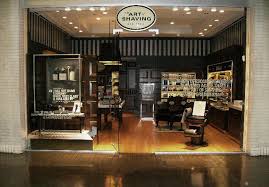 I was in Grand Rapids, Michigan, recently and “discovered” The Art of Shaving. It’s an upscale mall store that is dedicated to one thing and one thing only…the perfect shave for men. As it turns out, I could have discovered it in any one of dozens of malls nationwide. The company has been around since 1996 and its history is the perfect example of the power of innovation.
I was in Grand Rapids, Michigan, recently and “discovered” The Art of Shaving. It’s an upscale mall store that is dedicated to one thing and one thing only…the perfect shave for men. As it turns out, I could have discovered it in any one of dozens of malls nationwide. The company has been around since 1996 and its history is the perfect example of the power of innovation.
“There’s got to be a better way.”
That’s how good innovation starts. Co-founder Eric Malka said to his wife, “There’s got to be a better way to shave,” and the two of them set about finding it. Over time, they developed a four step system that lubricates, lathers, shaves, moisturizes, and turns the entire shaving ritual into something a man can actually look forward to. When I am finished shaving, my face feels so good I wish I could shave again. Sometimes I do.
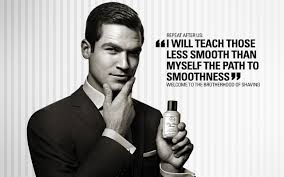
Innovation is Worth More
People are willing to pay more for real solutions, especially one-of-a-kind solutions. AoS virtually owns the high-end shaving market and they get a premium for their products. This is the real value of innovation. Higher margins, better sales, and loyal customers. In 2009, Procter and Gamble (owners of Gillette) bought The Art of Shaving and the company continues to grow.
Like I said, innovation is worth more.


